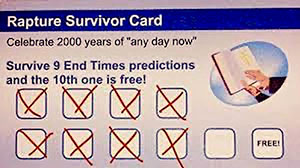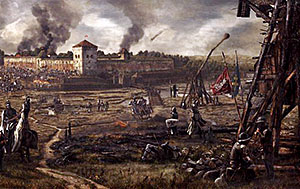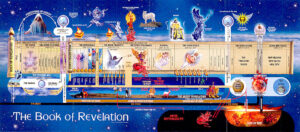Now that we’ve explored the challenges involved when interpreting prophesy, explored some commonly-bandied-about end-times terminology, and examined the significant historical events surrounding some of them, we’ll now tackle the prevalent mythos surrounding this complex topic. As the title of this article indicates, it involves the pervasive false beliefs arising from Hal Lindsey’s book.
The Great Awakenings of the 1800s

Sherman, set the Wayback Machine to the 19th century!
Yes, Mr. Peabody!Ripped off from Peabody’s Improbable History in
The Adventures of Rocky & Bullwinkle
The Second and Third Great Awakenings during the 19th century were amazing moves of God worldwide. D. L. Moody, Charles Spurgeon, William Booth, Hudson Taylor, R. A. Torrey, and other giants of the faith all walked the earth during that time, leading thousands to Jesus. The Holiness Movement, the forerunner of the 1906 Azuza Street Revival, also came about during this period.
John Nelson Darby
About 1840, a British minister named John Nelson Darby, left the Anglican Church to become one of the founders of the Plymouth Brethren. He subsequently came up with the systematic theology framework which we now know as dispensationalism.
Dispensationalism views history as divided into distinct periods in which God interacts with mankind in a specific way. Each of these periods is defined as a specific dispensation. The defining characteristics of a dispensation are the distinct governing relationship in which God interacts with mankind in the specific period, and the resulting responsibility placed upon mankind in each of these periods.
Wikipedia
Like all attempts at systematic theology before and since, dispensationalism has its flaws. All such theological endeavors are inherently imperfect because, as we already have discussed, they are devised by human beings trying to wrap their finite minds around the Infinite. Such frameworks are also suspect because of all the aforementioned interpretational challenges I mentioned in my first article in this series.
Unfortunately, Darby wasn’t the greatest exegete and some of his theological preconceptions are just plain wrong. One of his non-eschatologically-related doctrinal positions was actually heretical on its face. Tragically, no one during that era called him out for that. Instead, folks who were in a position to make that determination tended to gloss it over. All that being said, everything outside his end-times teachings seems to work pretty well theologically, though I cannot definitively weigh in on due to my lack of detailed study on that topic.
In fairness, Darby was not alone in expressing major-league bogus opinions about theology, philosophy, or science during that era. I have often opined that more religious, philosophical, and pseudo-scientific horse-hockey came out of the 19th century than any other period in human history. Darwinism, Marxism, existentialism, white supremacy, Mormonism, Christian Science, and the Jehovah’s Witnesses are merely low-hanging fruit when it comes to exemplars — lack of time and desire preclude my presenting an exhaustive list here — and tragically, all of that satanic list are like theological, philosophical, and sociological vampires refusing to die up to this modern day, no matter how valiantly some people have striven to drive a wooden stake through their hearts.
Darby’s Eschatological Influences
When it comes to the end times, Darby’s ideas on this topic were far from original.
Francisco Ribera [1]
Harkening a few centuries further back in time, the leading lights of the Protestant Reformation all thought they were living out the Book of Revelation during their day. They believed they were experiencing the Great Tribulation, the Roman Catholic cult was “Mystery, Babylon the Great, The Mother of Harlots and of the Abominations of the Earth” (see Revelation 17:5), and consistently portrayed the reigning Pope as the Antichrist in their writings as multitudes fled to the Protestant banner.
In an attempt to stem the mass exodus of Catholics to Protestantism, the Pope enlisted the help of a Spanish Jesuit theologian named Francisco Ribera (and no, he was not part of the Spanish Inquisition who no one expects! 🤣). In obedience to that papal command, Ribera authored in Latin a 500-page commentary on Revelation entitled Commentaries on the Apocalypse of the Blessed Apostle and Evangelist St. John. In that book, he invented a future-centric view of Revelation which sought to theologically debunk the Protestant’s propaganda campaign on the subject. His commentary was published in 1591 and immediately became official Roman Catholic dogma concerning the end times. It was then employed as a counter propaganda tool to reassure faithful Catholics it was indeed the reformers who were the real heretics.
Emmanuel Lacunza [1]
In 1812, another Spanish Jesuit theologian named Emmanuel Lacunza (tragically, no unexpected Spanish Inquisition here, either! 😀) published his own book in Latin entitled The Coming of the Messiah in Glory and Majesty which built upon the futurist ideology promulgated by Ribera. Employing a clever deception worthy of the Jesuits’ well-deserved reputation for such, it was published under the nom-de-plume of Ben-Ezra, who was supposedly a learned Messianic Jew.
Somehow that book found its way onto the bookshelves of the Archbishop of Canterbury, the Anglican/Episcopalian Church’s equivalent to a pope, and elsewhere.
It is crucial to note that all Protestants would have rejected this book out of hand had they been aware of its true authorship.
Edward Irving [1]
Lacunza’s book somehow landed in the hands of a Presbyterian minister in the Church of Scotland named Edward Irving. The book greatly influenced his thinking on the topic, so much so that he not only translated it into English, but later authored a 203-page preface for it in 1827. Irving, in turn, had an immense impact on none other than our dispensational protagonist, John Nelson Darby.
The Spread of Dispensationalism
Various evangelists latched onto Darby’s framework and spent the rest of the 19th century popularizing it, the most notable being D. L. Moody. It was then taught in various Bible institutes which arose during that period, Moody’s among them.
Both C. I. Scofield and Finis Jennings Dake embraced Darby’s teachings and permanently enshrined them in American evangelical thought via the Scofield Reference Bible first published in 1909 and Dake’s Annotated Reference Bible released in 1963.
Dispensationalism also became the core theological framework for the Dallas Theological Seminary (DTS) founded in the following century. It has remained a doctrinal touchstone among evangelicals — non-charismatic and charismatic alike! — ever since.
Dispensationalist Eschatology in the Modern Era
 In 1970, a minister named Hal Lindsey — himself a graduate of DTS — immensely popularized dispensationalism’s take on eschatology in his best-selling book The Late, Great Planet Earth. That book was virtually required reading for all evangelical Christians back then — especially members of the then-in-progress Charismatic Renewal/Jesus Movement. Prior to that book, most Christians had never even heard of eschatology as a branch of theological study.
In 1970, a minister named Hal Lindsey — himself a graduate of DTS — immensely popularized dispensationalism’s take on eschatology in his best-selling book The Late, Great Planet Earth. That book was virtually required reading for all evangelical Christians back then — especially members of the then-in-progress Charismatic Renewal/Jesus Movement. Prior to that book, most Christians had never even heard of eschatology as a branch of theological study.
The topics found in Lindsey’s book were on virtually all of our lips as we all breathlessly compared the day’s news headlines and political trends/events with his dispensationalist interpretation of Scripture. All our pseudo-analyses were liberally seasoned with heaping helpings of enthusiastic-but-ignorant theorizing along with more than a pinch of modern conspiracy theories, and garnished with a boatload of what can only be described as wild speculations and wishful thinking.
We constantly speculated on who the Antichrist candidate du jour; might be. Several schemes were put forward to discern that personage’s identity such as Hebrew numerology, just for one example. Such wild conjecture continues to this day with former US-presidents Obama and Trump being the latest candidates for that dubious honor.
Around that time, several movie production companies released end-times-focused, feature-length films of wildly varying performance and production values. All of them were ostensibly intended as evangelistic tools, but it was clear the producers were cashing in on the “rapture-mania” of the day.
 If all that wasn’t enough, between 1995 and 2007 a well-known American Baptist pastor and author named Tim LaHaye jumped on the bandwagon and co-wrote the “Left Behind” series which consisted of 16 near-future-sci-fi eschatological novels, all of which took the evangelical world by storm. The books described what it was like for those left behind after The Rapture and took its cast of characters from that event all the way through to Jesus’ millennial reign. The novels were later adapted into a series of five theatrical-release movies.
If all that wasn’t enough, between 1995 and 2007 a well-known American Baptist pastor and author named Tim LaHaye jumped on the bandwagon and co-wrote the “Left Behind” series which consisted of 16 near-future-sci-fi eschatological novels, all of which took the evangelical world by storm. The books described what it was like for those left behind after The Rapture and took its cast of characters from that event all the way through to Jesus’ millennial reign. The novels were later adapted into a series of five theatrical-release movies.
End-Times Specialists
Dispensationalist eschatology was further promoted by “end-times specialists,” such as J. Vernon McGee, Hilton Sutton, Jack Van Impe, and John Hagee, just to name four nationally-known ministers who immediately come to mind.Including Lindsey, all of these minister’s have created elaborate timelines for the end times (Hagee still has a painted mural of his timeline at the front of his church’s auditorium to this day). Much time and energy has been spent attempting to shoehorn modern events into them to show how close we are to “the end.”
Date Setters
 Several others, such as the late American Christian radio broadcaster and evangelist Harold Camping, made unscriptural attempts (see 1 Thessalonians 5:2, 2 Peter 3:10) to set specific dates for Jesus’ return, leading many spiritually immature and scripturally ignorant church-goers to quit their jobs, sell all their possessions, and wait on mountain-tops for the end to occur. As we all know, those dates came and went; bupkis!
Several others, such as the late American Christian radio broadcaster and evangelist Harold Camping, made unscriptural attempts (see 1 Thessalonians 5:2, 2 Peter 3:10) to set specific dates for Jesus’ return, leading many spiritually immature and scripturally ignorant church-goers to quit their jobs, sell all their possessions, and wait on mountain-tops for the end to occur. As we all know, those dates came and went; bupkis!
Though Lindsey himself never fell into the trap of precise date setting, he did write a second best-selling book in which he opined that the Battle of Armageddon would occur sometime before the end of the 1980s. That decade came and went; again, bupkis!
The Role of the USA
- Hilton Sutton committed hermeneutical violence on several Old Testament passages in a convoluted attempt to portray the USA in a positive light during the end-times. Why? So we patriotic American believers could feel good about how our country would fare despite it not being mentioned anywhere in Scripture.
- Pat Robertson, the founder of CBN, wrote his own novel entitled The End Of The Age, expressing yet another entirely different postmillennial take on the same concept.
- David Wilkerson of The Cross & The Switchblade renown weighed in with precisely the opposite; he opined the USA is Revelation’s “Babylon the Great” and would be completely destroyed in a single day by a surprise nuclear attack (a position I used to personally hold, I might add).
The endless wrangling over this and that end-times verse meaning something or another in the grand scheme of things has continued ceaselessly ever since, though admittedly the topic has faded from being front-and-center in many believers’ minds over the last few decades or so as dispensationalism’s eschatology has increasingly proven itself faulty.
The Church’s Siege Mentality
So why is all this of any never mind?
Back when Darby was devising his framework, Protestant beliefs were coming under increasing fire within Western Civilization. In other words, rather than the general public assuming the tenets of Christianity to be true on their face as had been the case during earlier eras, folks increasingly were calling that assumption into open question. This occurred on 3 fronts:
- The invasion of liberal theological thought (Schleiermacher, Ritschl, H. W. Beecher, Søren Kirkegaard, von Harnack, etc.) into mainline denominations — especially their seminaries — was rapidly progressing (the current apostasy we are witnessing within those denominations today has its roots in that doctrinal corruption)
- The writings of secular philosophers (Schopenhauer, Marx, Engels, Nietzsche, Hegel, Heidegger, etc.) was taking root among the European and American universities and intelligentsia.
- The pseudo-science of Darwin and others of that era contradicted the biblical narrative concerning the Creator and His creation.
Those views increasingly rendered the Scriptures as obsolete in the minds of the general public. That trend continues to this day, growing only steadily worse as any casual examination of modern culture will attest.
Darby reacted to that burgeoning trend by promoting a toxic and unscriptural mindset regarding what we can expect to see during the end times: we are now in the era of the lukewarm Laodicean church described in Revelation 3. Tragically, the Body of Christ has completely bought into his schtick, hook, line, and sinker.
That mindset can be defined as:

- The whole earth is relentlessly growing more and more evil by the day.
- The Church is under relentless attack, a beleaguered fortress beset both by barbarians at the gates and traitors in our midst.
- Despite Jesus’ Great Commission, we will ultimately lose our battle for the hearts and minds of the lost in the culture wars.
- We are helpless to effect any significant change in that trend, so all we can do is hunker down in our churches and endure (Calvinists would, of course, insert here “and suffer”) until Jesus rescues us at the Rapture of the Church which launches the Great Tribulation.
- He then returns and triumphs at Armageddon seven years later and judges all humankind by whether or not they are written in the Lamb’s Book of Life. He then establishes His 1000-year earthly reign.
- From there, the Church will reign alongside Him and live happily ever after.
In other words, church folks are awaiting God’s external military rescue from heaven, rather than seeking Him on how to influence our culture with His Kingdom values until He comes as taught by the Bible. Incidentally, that “influencing culture” mindset I just mentioned was held by the Puritans (Jonathan Edwards, etc.) and is also the eschatological view of the worldwide revival now in progress.
This “divine bailout” mindset has become so pervasive you pretty much cannot find an evangelical church anywhere on the planet that does not embrace this concept as an indisputable fact. I’ve literally watch a famous Calvinist-Baptist pastor and published author proclaim from his pulpit that “we’re going to lose.”
So Where Does That Leave Us?
I can only speak for myself here. You’ll have to draw your own conclusions. Here are mine:
- For the time being, I have revised my viewpoint on eschatology to partial preterism. That being said, just because I’m landing the plane of this article with that claim doesn’t mean my seeking God on this matter is over and done with. Instead, it seems like it’s merely gaining momentum. My next steps are to explore what some Messianic Jewish scholars have to say, especially about the Book of Daniel, and then we’ll see where that leads.
Stay tuned!
- I still have more questions than answers at the moment, but will cheerfully embrace any divine mysteries I encounter without having to compulsively wrap my puny mind around them.
- I no longer believe we are in the end-times with an imminent Rapture of the Church to supernaturally pull us out of here. Yes, I look forward to Jesus’ return. Yes, I love His appearing. Whether He does so within my lifetime — or not! — is anybody’s guess. But I refuse to view the Church in general and myself in particular as helpless victims until then.
- I no longer believe Bible prophesy is being fulfilled by every event/catastrophe covered by the drive-by media.
- I believe it is my responsibility/duty to fulfill my calling as a Christ-follower and minister of the Gospel to do whatever Jesus commands me to do to fulfill His Great Commission.
- I believe I am responsible for obeying Jesus’ command to love and forgive others, both our brethren and the lost, no matter how reprehensible their behaviors and/or repugnant their individual beliefs may be to me and others.
- I believe I am responsible for my own personal holiness, i.e., conducting myself in alignment with God’s standards of behavior and morality, all by the grace of God.
Now let me pose a question to you, my precious reader:
If you were absolutely certain Jesus was returning tomorrow, what, if anything, would you do differently from now until then?
If your answer is anything other than “Nothing new!” you’ve got a problem.
My point is this: we should already be doing everything Jesus commanded of us to the best of His ability in us by His grace and by the power of the Holy Spirit.
If not, we need to repent. How? By getting off our own bus and back onto His.
That is the only way we will hear those coveted words when we finally stand before Him:
“Well done, good and faithful servant!”
Selah!
Thanks for reading!
[1] from A Better End Times: There is a Better Future Before Jesus Returns by Dr. Dan Coflin


